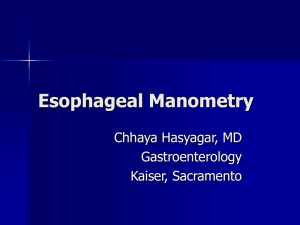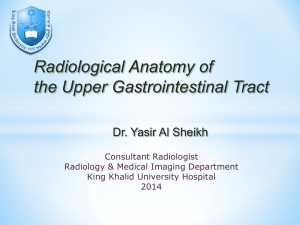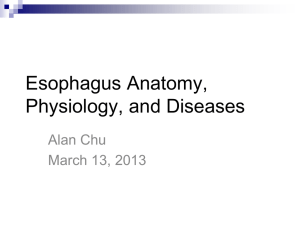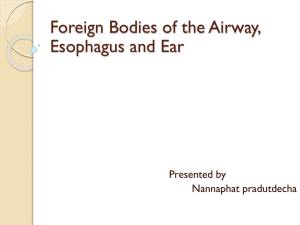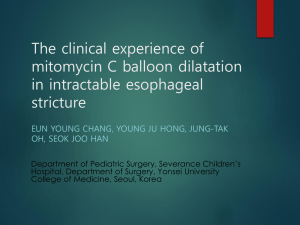Oncology - Esophageal Cancer
advertisement
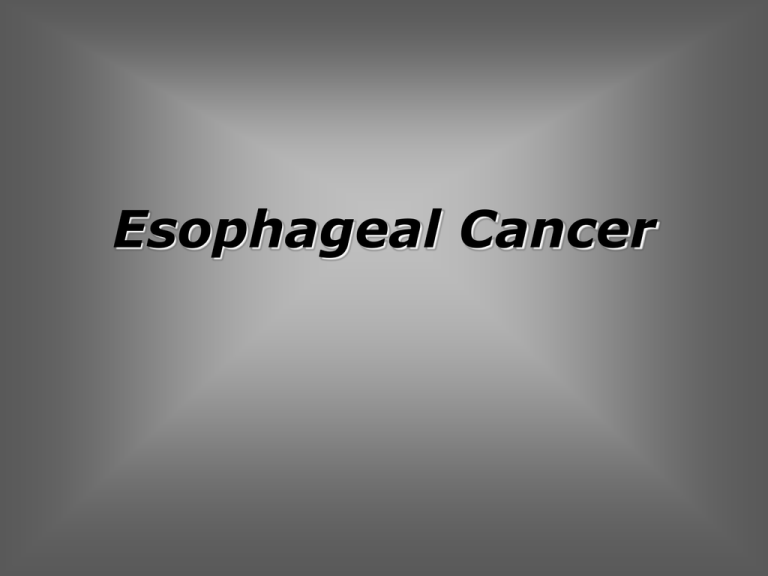
Esophageal Cancer Esophageal Cancer Cancer of the esophagus remains a devastating disease because it is usually not detected until it has progressed to an advanced incurable stage. Modern imaging techniques, including: 1. barium esophagraphy 2. contrast-enhanced computed tomography (CT) 3. magnetic resonance imaging (MRI) 4. endoscopic ultrasonography (EUS) 5. positron-emission tomography (PET) are powerful tools in the detection, diagnosis, and staging of this malignancy. Only surgical resection at a very early stage has been shown to improve survival rates in patients with this disease. Esophageal Cancer Frequency: In the US: • Cancer of the esophagus accounts for 7% of gastrointestinal tract cancers in the United States. • In 2000, approximately 12,300 new cases of esophageal carcinoma occurred in the United States, and 12,100 deaths resulted from the disease. • By the early 1990s, adenocarcinoma had become the most common cancerous cell type among white Americans, accounting for approximately one half of esophageal malignancies in the United States and Europe. Squamous cell cancers still predominate among African American patients. Internationally: • Esophageal cancer is the seventh leading cause of cancer death worldwide. • Unlike in the United States, squamous cell carcinoma is responsible for 95% of all esophageal cancer worldwide. Esophageal Squamous Cell Carcinoma Esophageal Adenocarcinoma Esophageal Cancer Signs and symptoms: • Dysphagia is the most common presenting symptom. Dysphagia is initially experienced for solids, but eventually it progresses to include liquids. Dysphagia usually occurs late in the course of the disease when the esophageal lumen has been narrowed by 50-75%. • Weight loss is the second most common symptom and occurs in more than 50% of people with esophageal carcinoma. • Pain can be felt in the epigastric or retrosternal area. It can also be felt over bony structures, representing a sign of metastatic disease. • Hoarseness caused by invasion of the recurrent laryngeal nerve is a sign of unresectability. • Respiratory symptoms can be caused by aspiration of undigested food or by direct invasion of the tracheobronchial tree by the tumor. The latter also is a sign of unresectability. • Stridor, cough, and aspiration pneumonia as the result of erosion into the tracheobronchial tree Esophageal Cancer X-ray findings: Barium esophagraphy is unique among esophageal studies for assessing both morphology and motility. Barium esophagraphy remains the study of choice for characterization of esophageal strictures. Esophageal carcinoma may demonstrate a variety of appearances on barium esophagrams: • Lesions may be annular and constricting; intraluminal, polypoid, or masslike; infiltrative; ulcerating; or varicoid. A mixed pattern is most common. • Early esophageal carcinoma may present as a small polypoid lesion or as coalescent plaques or nodules. TNM staging of esophageal carcinoma. M=metastasis; N=lymph node; T1-T4=depth of esophageal wall invasion. Esophageal Cancer Barium esophagram demonstrates an abrupt change in the caliber and contour of the esophagus caused by an irregular circumferential stricture containing focal ulcerations An ulcerative tumour growth measuring about 5cm longitudinally is present involving most of the circumference of oesophagus. The tumour has fairly sharply demarcated margins. Esophageal Cancer Anteroposterior barium esophagram demonstrates an abrupt change in the caliber of the esophagus, with a long, irregular, annular stricture of the lower esophagus. The masslike shouldering at the proximal extent of the lesion at which filling defects are present within the dilated esophageal lumen. Findings are most consistent with esophageal carcinoma. Esophageal Cancer Coil-type stent placed in a 75 year-old man with midesophageal squamous cell carcinoma. Coil-type stent placed in a 65 year-old woman with squamous cell carcinoma. Upper portion of stent on the left; view through the stent on the right. Esophageal Cancer CAT SCAN Findings: Contrast-enhanced CT plays an important role in the staging of esophageal carcinoma. Attention is directed to determining the extent of the local tumor; invasion of mediastinal structures; involvement of supraclavicular, mediastinal, or upper abdominal lymph nodes; and distant metastases. These observations are useful in distinguishing between T3 and T4 lesions and in determining the N and M status. Key findings include the following: 1. Eccentric or circumferential wall thickening is greater than 5 mm. 2. Peri-esophageal soft tissue and fat stranding may be demonstrated. 3. A dilated fluid- and debris-filled esophageal lumen is proximal to an obstructing lesion. Esophageal Cancer CT Findings Enhanced axial CT image demonstrates wall thickening of the esophagus. No significant loss of the fat plane is noted between the esophageal mass and the descending thoracic aorta, indicating the absence of aortic invasion. Esophageal Cancer CT Findings Enhanced axial CT image demonstrates irregular wall thickening of the esophagus. A heterogeneously enhancing mass to the right of the esophagus represents a markedly enlarged metastatic lymph node. Lack of the fat plane between the esophageal mass and the descending thoracic aorta, indicates the aortic invasion. Esophageal Cancer CT Findings Enhanced axial CT image demonstrates wall thickening of the esophagus on the level of esophageal hiatus. Carcinoma infiltrate the fundus of the stomach Esophageal Cancer CT Findings Nonenhanced axial CT image demonstrates dilated esophagus with a large amount of retained ingested food and a slight trace of barium. Nonenhanced axial CT image demonstrates wall thickening of the esophagus and complete obstruction of the esophageal lumen. Esophageal Cancer MRI MRI presents the advantage of direct multiplanar imaging capabilities, which may be of particular use in assessing tracheobronchial, aortic, and pericardial invasion. Preliminary studies have shown that the sensitivity and specificity of MRI for the determination of tumor invasion are equivalent to those of CT. r - thymus s - ascending aorta e - superior vena cava u - pulmonary trunk v - left pulmonary vein b - lung q - left main bronchus p - right main bronchus x - azygos vein g - esophagus c - descending aorta Esophageal Cancer Endoscopic ultrasonography (EUS) Unlike CT, EUS allows visualization of the distinct layers within the esophageal wall. Alternating circumferential layers define: the mucosal interface (hyperechoic), the mucosa (hypoechoic), the submucosa (hyperechoic), the muscularis propria (hypoechoic), and the adventitial interface (hyperechoic). Esophageal Cancer Endoscopic ultrasonography (EUS) Resolution of EUS permits the distinction of T1, T2, T3, and T4 tumors. Esophageal carcinoma appears as a hypoechoic lesion disrupting the normal circumferential layers. At this time, only EUS is useful in distinguishing T1 and T2 lesions. Esophageal Cancer Endoscopic ultrasonography (EUS) Esophageal carcinoma stage T1. EUS revealed a small hypoechoic irregular tumor that was infiltrating into echogenic submucosa but had not breached underlying muscularis. Esophageal Cancer Endoscopic ultrasonography (EUS) Esophageal carcinoma stage T2. The tumor (TU) invades muscle layer but does not penetrate through wall. LN=lymph node. Esophageal Cancer Endoscopic ultrasonography (EUS) Esophageal carcinoma (TU) penetrating through wall of esophagus (stage T3). LY-NO=lymph node. Esophageal Cancer Endoscopic ultrasonography (EUS) Esophageal carcinoma (stage T4) involving aorta (partial encasement) with loss of fat plane (interface) between tumor and aorta. Esophageal Cancer Nuclear medicine PET - Positron Emission Tomography PET is quickly becoming a standard oncologic imaging modality. The technique is useful not only for the primary detection of tumor and metastases but also for the further characterization of abnormalities discovered by using other imaging modalities. 2-[Fluorine 18]-fluoro-2-deoxy-D-glucose (FDG) is the most commonly used radiopharmaceutical. FDG PET scanning remains the technique of choice for the detection of metastatic abdominal lymph nodes. The sensitivity of FDG PET in assessing nodal metastasis is reportedly 33-83%, but studies have shown the superiority of FDG PET to CT and EUS for determining the N status. FDG PET is more sensitive than CT for the detection of distant metastases. Esophageal Cancer Nuclear medicine PET - Positron Emission Tomography History A 61-year-old female treated for breast cancer in 1981. A left cervical lymph node biopsied positive in 1995 and the patient received extensive radiation therapy to the left and anterior supraclavicular region. Referral was for a long severe stricture of the esophagus. PET/CT Findings The PET scan revealed significant uptake (SUV=4.5) in a soft tissue mass obstructing the cervical esophagus. Esophageal cancer From: http://www.petscaninfo.com/ Esophageal Cancer Nuclear medicine PET - Positron Emission Tomography History 69 year old male who has had difficulty swallowing that began approximately 3 or 4 months ago and has become progressively worse. It is only for solids and not liquids. CT Findings There is a dilated esophagus that is partially fluid filled. There is thickening of the distal esophagus just superior to the gastroesophageal junction. Esophageal cancer was diagnosed via esophageal biopsy, referred for initial staging. PET/CT Findings Chest: Focal intense increased FDG uptake in the distal esophagus (maximum SUV 9.0) corresponds with the esophageal thickening on CT scan. There is no abnormal focal increased activity in the bilateral lung parenchyma, hilum, mediastinal or axillary nodal regions. From: http://www.petscaninfo.com/
